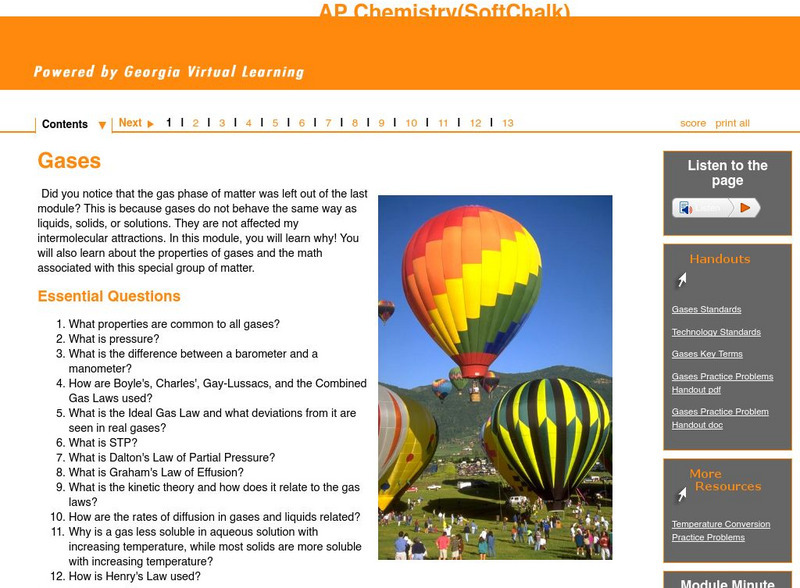Curated OER
Hot Gas Or Cold Gas Lab
Students engage in a lab project to study chemical reactions. They use guided questions to help facilitate the lab experience and come to the correct outcomes. The lesson does not contain a true understandable objective. The lesson could...
Curated OER
Is Air a Fluid?
Students use baking soda, vinegar, matches, and other materials to pour gas. In this air lesson plan, students use the materials to pour gas and learn that air can be a fluid like a liquid.
Curated OER
What's the Connection Between Convection and Inversion?
Ninth graders observe a simulation demonstrating the difference between convection and inversion. They explain where and when convection and inversion layers occur and how each impacts air quality, and by connection, human health.
Curated OER
Three Clouds Activity
Students explore how clouds are produced through three different age-appropriate hands-on experiments.
Curated OER
Reaction Kinetics
In this chemical reactions worksheet, students determine the reaction rate for various reactions, write balanced equations, create graphs showing the reaction over time, and calculate the activation energy and potential energy. This...
Curated OER
Isotopes; Molecular Notation; Electron Orbits
In this isotopes, molecular notation, and electron orbits worksheet, students read selections pertaining to isotopes, mass number, molecular notation, electric attraction, and electron orbits. In addition, students complete 11 short...
Curated OER
Isotopes
In this isotopes instructional activity, learners review mass number, molecular notation, electron attraction, and electron orbits. This instructional activity has 5 matching and 5 short answer questions.
Curated OER
Where My Peeps At?
Students conduct a series of activity that demonstrates Charles' and Boyle's Law. In this chemistry lesson, students determine the relationship among pressure, volume and temperature. They solve problems using mathematical equation.
Curated OER
Addendum to the Written Curriculum: Measuring Solids
Students use standard rulers to measure the length of common classroom items - such as pencils, books, desk tops - in inches and centimeters, and measure weight in pounds. They also answer math questions, such as "How long is the front...
Curated OER
Solids in Bottles
Pupils use funnels to put the five solid materials into clear bottles with caps. They observe how the particulate materials look, sound, and move when they shake and roll the bottle. Finally, students write "sound and touch" poetry.
Curated OER
Carbon Adventures Game
Sixth graders examine the processes and transformations that occur in carbon pools. They play a game to identify paths taken by carbon through the environment.
Curated OER
CO Buildup City
Students conduct a controlled experiment. They collect data in an organized manner. Students analyze data to reach a conclusion and communicate findings. They explain how city size, temperature, and pollution is related to the air quality.
Curated OER
Oxygen: What a Gas!
Eighth graders explain how oxygen reacts to other elements. They also explain why oxygen is a reactive substance, how it has weight, and how it reacts with other substances. They construct an experiment to relate their findings.
Curated OER
TIES MSEE Sensor Lesson Plan
Students explain how a sensor works. In this technology instructional activity, students determine the air quality around their school. They record observations and share results to class.
CK-12 Foundation
Ck 12: Fifth Grade Science: Physical Science: Solids, Liquids, and Gases
[Free Registration/Login may be required to access all resource tools.] Explains how to describe matter in the solid state, about the properties of liquid matter and gases, and what the relationship between energy and states of matter is.
Georgia Department of Education
Ga Virtual Learning: Ap Chemistry: Gases
In this module, you will learn why gases are not affected by intermolecular attractions! You will also learn about the properties of gases and the math associated with this special group of matter.
Khan Academy
Khan Academy: Ideal Gases in Medicine
This passage tests your knowledge on the kinetic molecular theory of gases using the five-question quiz.
Science Struck
Science Struck: Properties of Noble Gases
Read about the properties of the six noble gases - helium, neon, argon, krypton, xenon, and radon.
E-learning for Kids
E Learning for Kids: Norway Fjords: What Are Solids, Liquids and Gases?
The differences between solids, liquids, and gases and the properties of each are presented in this lesson.
University of Waterloo (Canada)
The University of Waterloo: The Heating Curve
The heat of vaporization along with several other thermal properties are explained. Sample problems are given. Illustrations.
BBC
Bb Ci Schools: Revisewise Science: Solids, Liquids, Gases
This site contains an interactive activity in which students can learn about the three states of matter. There is also a factsheet that lists numerous properties of liquids, solids, and gases. The factsheet also uses water as an example...
CK-12 Foundation
Ck 12: Physical Science: Gases
[Free Registration/Login may be required to access all resource tools.] Discusses properties of gases, why they exert pressure, and atmospheric pressure.
CK-12 Foundation
Ck 12: Physical Science: Noble Gases
[Free Registration/Login may be required to access all resource tools.] Group 18 elements and their properties.






















